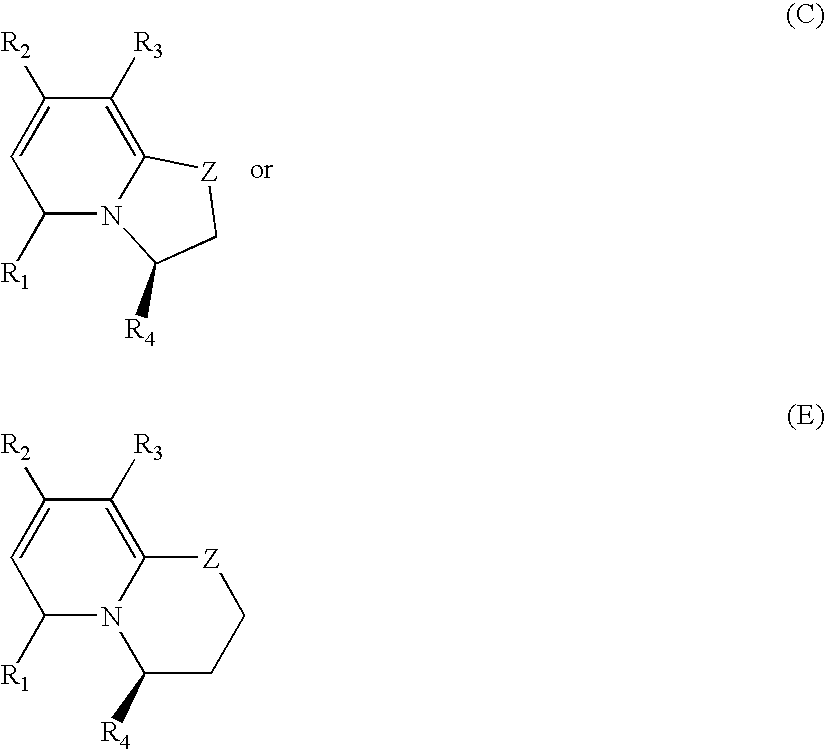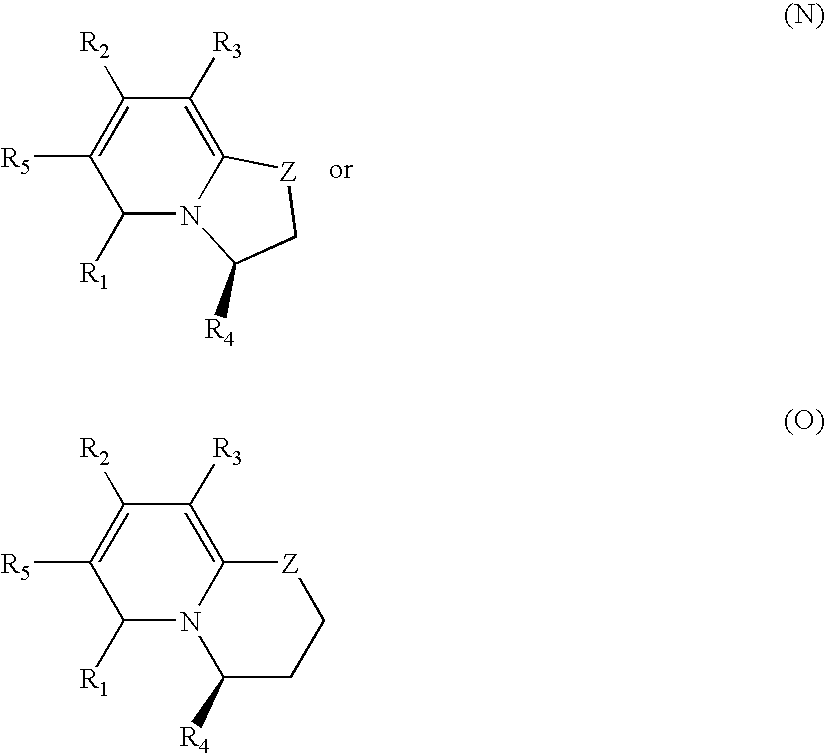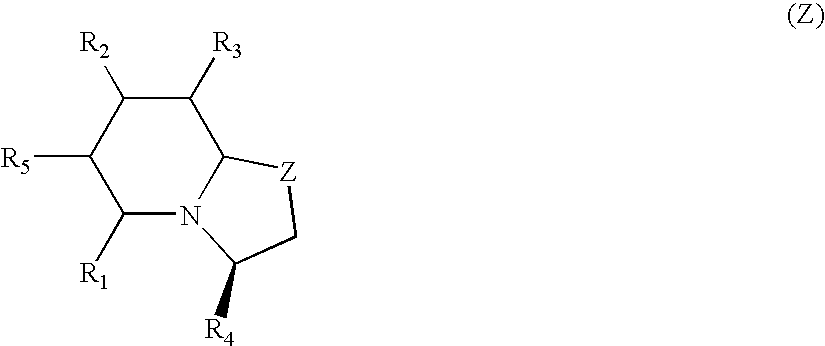Pyridinones to treat and prevent bacterial infections
a technology of pyridinones and bacterial infections, applied in the field of pyridinones, to achieve the effect of easy derivatization
- Summary
- Abstract
- Description
- Claims
- Application Information
AI Technical Summary
Benefits of technology
Problems solved by technology
Method used
Image
Examples
example 1
Synthesis of Pyridinone Methyl Ester
(3R)-7-(Naphthalen-1-ylmethyl)-5oxo-8-phenyl-2,3,-dihydro-5H-thiazolo(3,2-[α])pyridine-3-carboxylic acid methyl ester, 3. Meldrum's acid derivative 1 (1598 mg, 5.12 mmol) and thiazoline 2 (847 mg, 3.6 mmol) were dissolved in dry benzene (50 mL) and cooled to 5°-15° C. HCl gas was bubbled through the mixture for 15-45 minutes. The resulting turbid mixture was heated for 2-4 hours at 50°-70° C. and then cooled to room temperature. The resulting mixture was diluted with ethyl acetate and washed with water. The water phase was re extracted twice with CH2Cl2 and the combined organic extracts were dried (Na2SO4). Purification by silica gel chromatography (heptane:ethyl acetate, 50:50-10:90) gave pyridinone 3 as a white foam (470 mg, 53% yield from thiazoline 2). [a]D−12.8° (c 0.76, CHCl3); IR λ 3041, 2953, 1753, 1655, 1581, 1485, 793 cm−1; 1H NMR (400 MHZ, CDCl3) d 7.82 (dd, J 7.18, 2.13 Hz, 1H) 7.73 (d, J 8.25 Hz, 1H) 7.62 (dd, J 7.17, 1.82 Hz, 1H) 7.4...
example 2
Synthesis of Pyridinone Carboxylic Acid
(3R)-7-(Naphthalen-1-ylmethyl)-5-oxo-8-phenyl-2,3-dihydro-5H-thiazolo(3,2-[α])1, 4. NaOH (0.1 M, 13 mL) was added dropwise to a solution of 3 (545 mg, 1.28 mmol) in MeOH (38 mL) at room temperature. After stirring for 17 hours the mixture was evaporated and the residue was dissolved in HOAc. The solution was transferred to a test tube and water was added at which the product precipitated. After centrifugation the liquid was removed and the residue was washed once with water. Freeze drying from Water / HOAc (8:2) gave pure 4 (487 mg, 92%) as a white powder. [a]D−16.7° (c 0.33, dioxane:MeOH, 5:1); IR 1 cm−1 3610-3114 (broad), 2972, 2893, 1726, 1616, 1537, 1483, 1441, 1192, 781, 702;1H NMR (400 MHZ, CDCl3) d 10.20 (s, broad, 1H) 7.72 (d, J 7.17 Hz, 1H) 7.58 (dd, J 18.32, 7.57 Hz, 2H) 7.38-7.17 (m, 9H) 7.06 (s,1H) 5.72 (s, 1H) 5.28 (s, 1H) 3.93 (d, J 16.51 Hz, 1H) 3.74 (d, J 16.0 Hz, 1H) 3.51 (s, 1H) 3.16 (s, 1H); 13C NMR (100 MHZ, CDCl3) d 168.4, 15...
example 3
Synthesis of Pyridinone Sulfone Methyl Ester
(3R)-7-(Naphthalen-1-ylmethyl)-1,1,5-trioxo-8-phenyl-1,2,3,5-tetrahydro-1λ6-thiazolo(3,2-[α])pyridine-3-carboxylic acid methyl ester, 5. A solution of MCPBA (744 mg, 4.31 mmol) in CH2Cl2 (34 mL) was added dropwise to a solution of 3 in CH2Cl2 (24 mL) at −78° C. The mixture was kept at −78° C. for one hour and then the cooling bath was removed. After stirring overnight the mixture was diluted with CH2Cl2 and then ice was added. The organic phase was washed several times with NaHCO3 (sat, aq), the combined water was re extracted with CH2Cl2 twice and then the organic phases were combined and dried (Na2SO4 aq free). Concentration at reduced pressure followed by flash chromatography (SiO2, heptane:ethyl acetate, 1:1®1:3) gave pure5 (317 mg, 80%). [a]D−1.7° (c 2.74, CHCl3); IR λ, 3010, 2953, 1751, 1664, 1593, 1336, 1213, 1134, 748, 700 cm−1; 1H NMR (400 MHZ, CDCl3) δ 7.86 (dd, J 6.30, 2.16 Hz, 1H) 7.79 (d, J 8.21 Hz, 1H) 7.60-7.38 (9 H) 7.23 (m...
PUM
| Property | Measurement | Unit |
|---|---|---|
| acid | aaaaa | aaaaa |
| structure | aaaaa | aaaaa |
| flexible | aaaaa | aaaaa |
Abstract
Description
Claims
Application Information
 Login to View More
Login to View More - R&D
- Intellectual Property
- Life Sciences
- Materials
- Tech Scout
- Unparalleled Data Quality
- Higher Quality Content
- 60% Fewer Hallucinations
Browse by: Latest US Patents, China's latest patents, Technical Efficacy Thesaurus, Application Domain, Technology Topic, Popular Technical Reports.
© 2025 PatSnap. All rights reserved.Legal|Privacy policy|Modern Slavery Act Transparency Statement|Sitemap|About US| Contact US: help@patsnap.com



